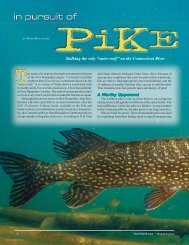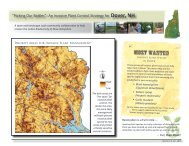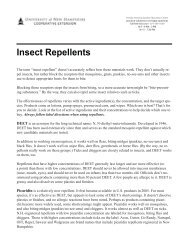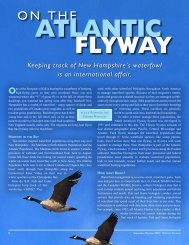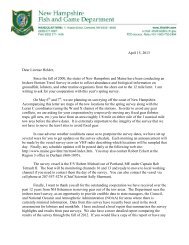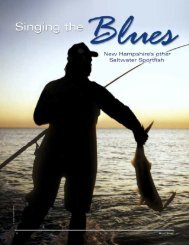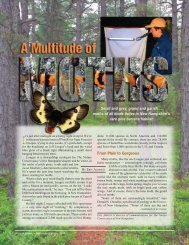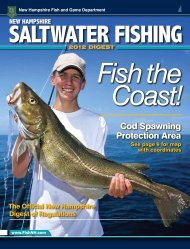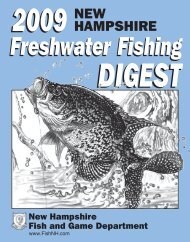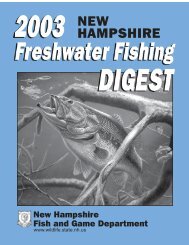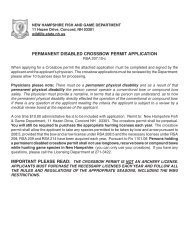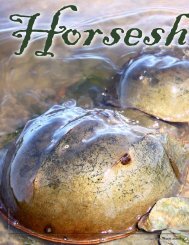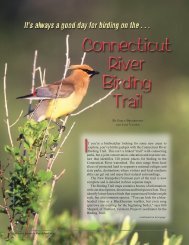Mad for Molluscs - New Hampshire Fish and Game Department
Mad for Molluscs - New Hampshire Fish and Game Department
Mad for Molluscs - New Hampshire Fish and Game Department
Create successful ePaper yourself
Turn your PDF publications into a flip-book with our unique Google optimized e-Paper software.
LISA NASH PHOTO<br />
8 July/August 2006 • WILDLIFE JOURNAL
What do shellfish tell us about our environment...<br />
<strong>and</strong> how can I get some <strong>for</strong> supper?<br />
hellfish – mussels, clams, oysters <strong>and</strong> others – aren’t just<br />
good <strong>for</strong> chowder or bait. As filter feeders <strong>and</strong> as food <strong>for</strong><br />
other creatures, shellfish are critical components of marine<br />
ecosystems that contribute to healthy waters, <strong>and</strong> they can<br />
help indicate when waters aren’t healthy.<br />
Shellfish filter tremendous amounts of water each day, <strong>and</strong><br />
in doing so, help keep water clear <strong>and</strong> clean. The<br />
health of shellfish is directly related to the water<br />
quality of the local environment — because they<br />
filter great amounts of water, shellfish absorb contaminants<br />
from the water that accumulate in their<br />
flesh. This means if a clam is living in dirty water that has high<br />
levels of bacteria, that clam will also contain high levels of<br />
bacteria <strong>and</strong> be unsafe to eat. It’s a simple equation: Healthy<br />
shellfish equal clean water.<br />
Because of the close relationship between shellfish <strong>and</strong><br />
water quality, the <strong>New</strong> <strong>Hampshire</strong> <strong>Department</strong> of Environmental<br />
Services Shellfish Program, the <strong>New</strong> <strong>Hampshire</strong> Estuaries<br />
Project <strong>and</strong> other partners are working to monitor shellfish in<br />
<strong>New</strong> <strong>Hampshire</strong> <strong>and</strong> make their restoration <strong>and</strong> maintenance a<br />
priority, as well as to open more harvesting areas <strong>and</strong> support<br />
education about these ecologically important species.<br />
Declining Clams <strong>and</strong> Oysters<br />
Although many kinds of shellfish are available <strong>for</strong> harvest,<br />
the populations of some species have fallen on hard times in<br />
recent years. Researchers estimated a harvestable softshell<br />
clam population in Hampton/Seabrook harbor of 25,000 bushels<br />
in 1997, but that number had fallen to 3,276 bushels in 2003,<br />
<strong>and</strong> has not recovered since. Scientists believe there are multiple<br />
reasons <strong>for</strong> the decline. Some feel the ups <strong>and</strong> downs are<br />
typical of a common predator-prey relationship: when clams<br />
are plentiful, there is greater harvesting pressure, <strong>and</strong> populations<br />
decline. Once it becomes hard to find clams, harvest<br />
pressure eases, <strong>and</strong> the clams eventually rebound. Other factors,<br />
such as disease <strong>and</strong> predation by green crabs, also appear<br />
to play a role.<br />
Oyster populations have also significantly declined in recent<br />
years. Biologists estimated over 128,000 bushels of harvestable<br />
oysters in <strong>New</strong> <strong>Hampshire</strong> in 1993. Today, the annual harvest<br />
is about 6,700 bushels. Most researchers believe the major<br />
cause of this decline was the impact of two oyster diseases,<br />
MSX <strong>and</strong> Dermo. These diseases weaken oysters <strong>and</strong> either kill<br />
BY CHRIS NASH<br />
them outright or make them more susceptible to other hazards.<br />
Oyster fisheries in the Chesapeake Bay <strong>and</strong> other mid-Atlantic<br />
estuaries also have been severely damaged by these two diseases<br />
<strong>and</strong> have not recovered.<br />
Is there any good news? Yes, there appear to be a good<br />
number of juvenile oysters in several <strong>New</strong> <strong>Hampshire</strong> beds as<br />
a result of a successful breeding season in 2002, <strong>and</strong><br />
these oysters currently are at or close to harvestable<br />
size. Also, several oyster restoration projects sponsored<br />
by the N.H. Estuaries Project, the University<br />
of <strong>New</strong> <strong>Hampshire</strong> Jackson Estuarine Laboratory<br />
<strong>and</strong> other organizations are beginning to produce positive<br />
results.<br />
On the Flats<br />
Although clam <strong>and</strong> oyster populations themselves may be in<br />
decline, the number of areas open to harvest continues to<br />
increase, giving harvesters more areas to seek their limit. Since<br />
2000, over 600 acres of estuarine waters have been reopened to<br />
harvesting.<br />
Shellfish are<br />
an important food<br />
source to many<br />
other marine species<br />
– <strong>and</strong> to<br />
humans too. Seafood<br />
lovers know<br />
that “fresh is<br />
best,” <strong>and</strong> hundreds<br />
of <strong>New</strong><br />
<strong>Hampshire</strong> residents<br />
know the<br />
secret to getting<br />
the freshest shellfish<br />
around – dig Estuarine mudflats provide habitat <strong>for</strong><br />
’em yourself! A softshell clams. Clams can also be found<br />
modest amount of in the muddy shorelines adjacent to tidal<br />
shellfish harvesting,<br />
done with that the area they intend to dig is open<br />
creeks. Harvesters should always verify<br />
care using traditional<br />
tools, does<br />
<strong>for</strong> harvesting.<br />
not have a significant impact on overall populations.<br />
continued on next page<br />
WILDLIFE JOURNAL • July/August 2006 9<br />
CHRIS NASH PHOTO
If you’ve never tried shellfishing be<strong>for</strong>e, here’s<br />
a primer on what you might find in <strong>New</strong> <strong>Hampshire</strong>,<br />
plus locations <strong>and</strong> techniques <strong>for</strong> various<br />
popular species:<br />
Softshell clams: Commonly known<br />
as “steamers,” these clams are common<br />
in <strong>New</strong> <strong>Hampshire</strong>’s tidal mudflats.<br />
They can grow to a size of five inches or<br />
more across, but two-to-three inch<br />
clams are typically sought <strong>for</strong> food.<br />
The clams burrow in the mud, extending<br />
their siphon to feed during high<br />
tide, <strong>and</strong> leaving their tell-tale “clam<br />
hole” when they retract their siphon at<br />
low tide. When disturbed, they often<br />
squirt water from their siphon. These<br />
clams do not completely close their<br />
shells, which are brittle <strong>and</strong> easily broken. They<br />
burrow into the mud anywhere from a few inches<br />
to 18 inches, <strong>and</strong> are dug with short-h<strong>and</strong>led<br />
“clam <strong>for</strong>ks.” The most popular <strong>New</strong> <strong>Hampshire</strong><br />
location <strong>for</strong> clamming is the Hampton/Seabrook<br />
estuary, although other areas such as Little Harbor,<br />
Great Bay <strong>and</strong> the Bellamy River also have<br />
softshell clams.<br />
American oysters: Oysters typically<br />
grow in large “reefs” at or below the<br />
low-tide line. Their irregularly shaped<br />
shells tend to be cemented to rocks,<br />
pilings or other oysters. Live oysters<br />
tightly close their shells, which tend to<br />
have a concave shape on the bottom<br />
side. Oysters are typically harvested by<br />
boat with long-h<strong>and</strong>led tongs, which<br />
are used to bring up a mass of oysters,<br />
rock, shell <strong>and</strong> mud from the reef. The<br />
larger, live oysters are then “culled”<br />
from the smaller oysters, shell <strong>and</strong> rock.<br />
Some oyster locations are harvestable without a<br />
boat – there, chest waders <strong>and</strong> “bullrakes” or<br />
short-h<strong>and</strong>led tongs are commonly used. In <strong>New</strong><br />
<strong>Hampshire</strong>, the Great Bay estuary is known as the<br />
prime location <strong>for</strong> oysters, with Adams Point in<br />
Durham <strong>and</strong> Nannie Isl<strong>and</strong> in Great Bay offering<br />
some of the largest oyster “beds” in the estuary.<br />
Blue mussels: Blue mussels have a<br />
smooth, bluish-black shell <strong>and</strong> tend to<br />
live in rocky areas of estuaries <strong>and</strong> the<br />
ocean. They often grow in clumps, attaching<br />
themselves to rocks or to each<br />
other by means of their “beard,” or<br />
byssal threads. They are typically harvested<br />
by h<strong>and</strong> at low tide, although<br />
some commercial fishermen operate<br />
blue mussel “farms” in the open ocean.<br />
The largest blue mussel populations<br />
available <strong>for</strong> recreational harvest are in<br />
the Hampton/Seabrook estuary; smaller populations<br />
can be found up <strong>and</strong> down the rocky Atlantic<br />
Coast <strong>and</strong> in Little Harbor.<br />
Surf clams:<br />
Typically harvested<br />
<strong>for</strong> chowders, these<br />
large clams have a<br />
very hard shell <strong>and</strong><br />
are primarily found<br />
in the open ocean.<br />
Surf clams can be<br />
picked from the<br />
beach following<br />
strong coastal<br />
storms. Wearing<br />
chest waders <strong>and</strong><br />
using heavy-tined pitch<strong>for</strong>ks or rakes, recreational<br />
diggers pursue surf clams on very low tides along<br />
the beaches of Hampton <strong>and</strong> Rye. Surf clams can<br />
be “raked” with a variety of long-h<strong>and</strong>led tools<br />
such as garden spading <strong>for</strong>ks, garden cultivators,<br />
or specialized bullrakes. Hampton Beach, North<br />
Beach <strong>and</strong> Jenness Beach are popular locations<br />
<strong>for</strong> harvesting surf clams.<br />
Razor clams:<br />
Named <strong>for</strong> their<br />
long, streamlined<br />
shape, razor clams<br />
are sometimes<br />
found in the same<br />
mud <strong>and</strong> s<strong>and</strong>flats<br />
as softshell clams.<br />
Their clam hole<br />
tends to have more<br />
of a keyhole shape,<br />
as opposed to the<br />
round hole of a<br />
softshell clam. Harvesters need to be quick with<br />
their clam <strong>for</strong>k, because razor clams can burrow<br />
out of reach with surprising speed.<br />
Monitoring <strong>for</strong> Safety<br />
Clams, oysters <strong>and</strong> mussels eat by filtering out<br />
microscopic bits of food in the water. In this filterfeeding<br />
process, shellfish can pick up contaminants<br />
from the water, including disease-causing bacteria<br />
<strong>and</strong> viruses. Humans who then harvest <strong>and</strong><br />
consume contaminated shellfish can contract a<br />
variety of illnesses. For this reason, the N.H.<br />
<strong>Department</strong> of Environmental Services examines<br />
the pollution risk to shellfish harvesting areas.<br />
Some areas show a high degree of pollution risk<br />
because of nearby pollution sources, or because of<br />
high bacteria levels observed through sampling<br />
programs. Shellfish harvesting is never allowed in<br />
these “closed” areas. Some areas may show pollution<br />
risk under certain types of weather conditions,<br />
or during certain times of the year; these “open”<br />
NH DES SHELLFISH PROGRAM PHOTOS<br />
10 July/August 2006 • WILDLIFE JOURNAL
areas are still subject to temporary closures, which<br />
can last days, weeks, or even months, depending<br />
on the kinds of pollution sources in the area.<br />
In some years, an ocean outbreak of Paralytic<br />
Shellfish Poisoning, or PSP, – commonly known<br />
as “red tide” – can make <strong>New</strong> <strong>Hampshire</strong>’s shellfish<br />
off-limits to harvesters <strong>for</strong> long periods. PSP<br />
is caused by a “bloom” of toxic organisms, <strong>and</strong><br />
can be dangerous or even deadly to humans who<br />
eat contaminated shellfish.<br />
In addition to pollution or PSP-related<br />
shellfishing closures, N.H. <strong>Fish</strong> <strong>and</strong> <strong>Game</strong> implements<br />
restrictions <strong>for</strong> resource conservation<br />
purposes, which vary by species. The best way <strong>for</strong><br />
harvesters to keep track of what areas are open is<br />
to consult the maps in the N.H. <strong>Fish</strong> <strong>and</strong> <strong>Game</strong>’s<br />
Saltwater Digest, or on the <strong>Department</strong> of Environmental<br />
Services website at<br />
www.des.state.nh.us. If an area is shown as being<br />
open, harvesters should then consult the “Clam<br />
Flat Hotline” (1-800-43-CLAMS) to see if a temporary<br />
closure is in place <strong>for</strong> their area of interest.<br />
Tools of the Trade<br />
Shellfish harvesting does not require a large<br />
investment in equipment, though clam or oyster<br />
harvesters — N.H. residents only — must get a<br />
$30 permit from any license agent. Shellfish areas<br />
tend to be wet, muddy <strong>and</strong> sometimes slippery<br />
places, so rubber boots are a good idea. Hip or<br />
chest waders are ideal <strong>for</strong> keeping mud off your<br />
clothes (<strong>and</strong> the inside of your car!), crossing tidal<br />
creeks, <strong>and</strong> wading into knee-deep water to rinse<br />
your shellfish <strong>and</strong> equipment. Gloves to protect<br />
h<strong>and</strong>s from sharp shells <strong>and</strong> abrasive s<strong>and</strong> <strong>and</strong><br />
mud are also a good idea.<br />
Harvesting mussels requires no equipment, as<br />
it is typically done by h<strong>and</strong>. But a clam <strong>for</strong>k is<br />
needed to dig <strong>for</strong> softshell or razor clams. H<strong>and</strong>les<br />
must be less than 18" long, <strong>and</strong> can be purchased<br />
from local marine equipment <strong>and</strong> fishing tackle<br />
stores.<br />
You need some sort of basket to hold your<br />
catch. Some people buy a specialized metal clam<br />
basket, which allows water <strong>and</strong> mud to flow<br />
through <strong>and</strong> helps with the task of rinsing mud off<br />
the shellfish. If you plan to use a plain 5-gallon<br />
bucket, make a line with permanent marker at the<br />
10-quart mark, to ensure you don’t exceed the<br />
daily limit. Keep in mind that your license number<br />
must be clearly marked on the outside of the clam<br />
container <strong>and</strong> your license must be worn in plain<br />
view while harvesting.<br />
Oyster tongs are long-h<strong>and</strong>led, hinged implements<br />
that can be a little more challenging to find,<br />
but are necessary <strong>for</strong> accessing oysters in deeper<br />
water. Check the Internet <strong>for</strong> companies that manufacture<br />
them.<br />
continued on next page<br />
Proper clam digging is one way to help protect <strong>and</strong> improve <strong>New</strong> <strong>Hampshire</strong><br />
clam stocks. Here’s the best technique:<br />
1. Select <strong>and</strong> cut a manageable<br />
section of flat on four sides.<br />
3.Turn the piece of flat completely<br />
over <strong>and</strong> place it in the resulting<br />
furrow. (Placing the piece to one<br />
side may needlessly cover an undug<br />
area with small clams vulnerable to<br />
smothering.)<br />
5.With <strong>for</strong>k tines straight downward,<br />
gently break up the section of flat to<br />
expose the remaining clams.<br />
2.Try to judge the location <strong>and</strong> depth<br />
of most clams of suitable size. Work<br />
<strong>for</strong>k into the flat with gentle rocking<br />
motion, adjusting angle of <strong>for</strong>k to<br />
move between <strong>and</strong> under the clam<br />
burrows.<br />
4.Pick out the exposed clams that<br />
are of suitable size.<br />
NECK<br />
FOOT<br />
6.When all harvestable clams have<br />
been taken from the piece, simply<br />
leave it as it lies in the furrow. This<br />
protects the remaining clams from<br />
predators such as crabs <strong>and</strong> gulls.<br />
Clams not harvested will gradually<br />
return to an upright feeding position.<br />
NH DES SHELLFISH PROGRAM PHOTO<br />
A clam <strong>for</strong>k is the<br />
best tool <strong>for</strong> turning<br />
over sections of mud<br />
flat to find softshell<br />
clams.<br />
WILDLIFE JOURNAL • July/August 2006 11
One fringe benefit <strong>for</strong><br />
the early-morning<br />
shellfish harvester is<br />
seeing sunrise on the<br />
flats, like this one at<br />
Berry Brook.<br />
CHRIS NASH PHOTO<br />
If harvesting surf clams, a raincoat over your<br />
chest waders helps prevent a thorough soaking<br />
from breaking waves. H<strong>and</strong> rakes, spading <strong>for</strong>ks<br />
<strong>and</strong> garden tools can be used to probe the s<strong>and</strong> <strong>and</strong><br />
dig out the clams, but the back <strong>and</strong> <strong>for</strong>th water<br />
motion in the surf can make it difficult to get a surf<br />
clam into your basket. The built-in basket in a<br />
commercial bullrake helps solve this problem.<br />
After the Harvest<br />
Now that you’ve got your shellfish, what next?<br />
Here are a few suggestions on keeping your shellfish<br />
fresh <strong>and</strong> preventing possible health issues<br />
from improperly h<strong>and</strong>led or stored shellfish:<br />
● Clean your shellfish of external mud <strong>and</strong><br />
debris by rinsing in water where you dug them. At<br />
home, rinse <strong>and</strong> scrub the shells under running<br />
water.<br />
● KEEP THEM COLD! Transfer your shellfish<br />
to a clean cooler with ice or ice packs <strong>for</strong> the<br />
trip home, <strong>and</strong> refrigerate them right away when<br />
you get home.<br />
● Some people like to soak their softshell clams<br />
to get them to purge themselves of dirt <strong>and</strong> grit<br />
inside the shell. If you use local seawater <strong>for</strong> this<br />
purpose, collect it in a clean container, <strong>and</strong> only<br />
take water from areas that are approved <strong>for</strong> harvesting<br />
(you don’t want to soak your clams in<br />
polluted water!)<br />
● Store shellfish in an open plastic or glass<br />
container, cover with a clean wet towel, <strong>and</strong> store<br />
in a dry, cool place – a refrigerator temperature<br />
between 32 <strong>and</strong> 42 degrees is ideal. Never store<br />
shellfish in an airtight container. If using ice, keep<br />
the shellfish separate from the melt water.<br />
● Some people store their live shellfish <strong>for</strong> later<br />
use by hanging them underwater in mesh bags<br />
from their shoreline dock or boat. This can be<br />
hazardous, especially if the surrounding water is<br />
prone to pollution, such as waters that are closed<br />
to shellfish harvesting. Proper refrigeration <strong>and</strong><br />
quick consumption within a day or two of harvest<br />
is the best way to ensure high quality <strong>and</strong> avoid<br />
health issues.<br />
● All types of food, including shellfish harvested<br />
from approved waters, can carry health risks. Shellfish<br />
harvested from approved waters <strong>and</strong> h<strong>and</strong>led/<br />
stored properly carry minimal health risks if consumed<br />
raw by healthy individuals. According to<br />
the <strong>New</strong> <strong>Hampshire</strong> Bureau of Risk Assessment,<br />
people with certain medical conditions — such as<br />
liver disease, reduced stomach acidity or a weakened<br />
immune system — may be particularly<br />
susceptible to serious illnesses, <strong>and</strong> should avoid<br />
eating raw or partially cooked shellfish.<br />
When Can I Go Clamming?<br />
<strong>New</strong> <strong>Hampshire</strong>’s softshell clamming season<br />
opens September 9, 2006 (the first Saturday after<br />
Labor Day) <strong>and</strong> runs through the end of<br />
May. Clamming is on Saturdays only, <strong>and</strong> not all<br />
areas are open throughout the season – <strong>for</strong> example,<br />
Hampton/Seabrook or Little Harbor often have poor<br />
water quality in early fall <strong>and</strong> are generally not open to<br />
shellfish harvesting until later. Similarly, some areas<br />
may be closed <strong>for</strong> the summer be<strong>for</strong>e the end of<br />
May. A clam license (available only to <strong>New</strong> <strong>Hampshire</strong><br />
residents) is required <strong>for</strong> softshell clamming.<br />
No license is needed <strong>for</strong> recreational<br />
harvest by h<strong>and</strong> of surf clams,<br />
mahogany quahogs <strong>and</strong> razor clams<br />
on the sections of Atlantic coast open<br />
<strong>for</strong> harvest; pending acceptable<br />
water quality conditions, this season<br />
is open year-round <strong>and</strong> not<br />
limited to Saturdays.<br />
Call 1-800-43-CLAMS <strong>for</strong> updates<br />
on closures. For harvest limits, maps, equipment<br />
regulations <strong>and</strong> other details, consult the N.H.<br />
Saltwater <strong>Fish</strong>ing Digest at www.nhfg.net or the<br />
N.H. Shellfish Program page at http://des.nh.gov/<br />
wmb/shellfish.<br />
● Discard dead shellfish. Most shellfish keep<br />
their shells closed when alive (note that softshell,<br />
or steamer clams, cannot completely close their<br />
shells). Discard shellfish with gaping/open shells,<br />
as well as those that are broken, damaged or have<br />
a foul odor <strong>and</strong>/or dried meat.<br />
● When cooking shellfish, avoid cross-contamination<br />
of raw with cooked shellfish. Keep<br />
utensils, work surfaces <strong>and</strong> cooking areas clean.<br />
● Raw shellfish can be frozen <strong>for</strong> later use, but<br />
the thawed meats are softer <strong>and</strong> typically used<br />
only <strong>for</strong> cooking. To freeze shellfish, clean thoroughly<br />
<strong>and</strong> freeze either in the shell or shucked.<br />
Quick freezing minimizes tissue damage. Shellfish<br />
should be stored in their own “liquor,” or<br />
water. Remove excess air to avoid freezer burn.<br />
Frozen shellfish should be thawed in the refrigerator<br />
<strong>for</strong> 24 hours, <strong>and</strong> should not be refrozen.<br />
• • •<br />
Whether you’re looking <strong>for</strong> dinner or just a nice<br />
day “digging” the <strong>New</strong> <strong>Hampshire</strong> seacoast, there’s<br />
nothing like a muddy sunrise seeking shellfish on the<br />
flats to appreciate the important ecological role they<br />
play in our estuarine environment.<br />
Chris Nash heads the N.H. <strong>Department</strong> of Environmental<br />
Services Shellfish Program.<br />
Portions of this article originally appeared in<br />
the <strong>New</strong> <strong>Hampshire</strong> Estuaries Project “Shellfish<br />
Spotlight.”<br />
12 July/August 2006 • WILDLIFE JOURNAL



